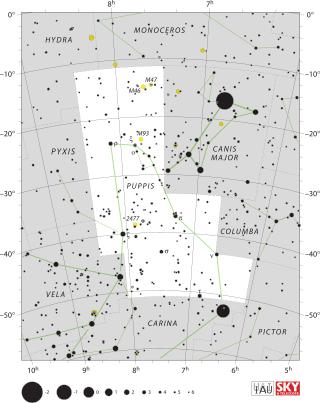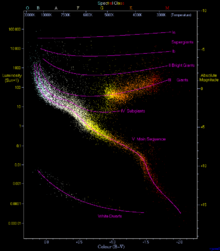
Epsilon Indi, Latinized from ε Indi, is a star system located at a distance of approximately 12 light-years from Earth in the southern constellation of Indus. The star has an orange hue and is faintly visible to the naked eye with an apparent visual magnitude of 4.83. It consists of a K-type main-sequence star, ε Indi A, and two brown dwarfs, ε Indi Ba and ε Indi Bb, in a wide orbit around it. The brown dwarfs were discovered in 2003. ε Indi Ba is an early T dwarf (T1) and ε Indi Bb a late T dwarf (T6) separated by 0.6 arcseconds, with a projected distance of 1460 AU from their primary star.
HD 169830 is a star in the southern constellation of Sagittarius. It has a yellow-white hue and is dimly visible to the naked eye with an apparent visual magnitude of +5.90. The star is located at a distance of 120 light years from the Sun based on parallax. It is drifting closer with a radial velocity of −17.3 km/s, and is predicted to come as close as 20.7 ly (6.4 pc) in 2.08 million years. HD 169830 is known to be orbited by two large Jupiter-like exoplanets.
HD 75289 is a faint double star in the southern constellation of Vela. The primary component has a yellow hue and an apparent visual magnitude of 6.35. Under exceptionally good circumstances it might be visible to the unaided eye; however, usually binoculars are needed. The pair are located at a distance of 95 light years from the Sun based on parallax, and are drifting further away with a radial velocity of +10 km/s.
HD 20367 is a star in the constellation of Aries, close to the border with the Perseus constellation. It is a yellow-white hued star that is a challenge to view with the naked eye, having an apparent visual magnitude of 6.40. Based upon parallax measurements, it is located 85 light years from the Sun. It is drifting further away with a radial velocity of +6.5 km/s. Based upon its movement through space, it is a candidate member of the Ursa Major Moving Group of co-moving stars that probably share a common origin.
HD 65216 is a triple star system with two exoplanetary companions in the southern constellation of Carina. With an apparent visual magnitude of 7.97 it cannot be readily seen without technical aid, but with binoculars or telescope it should be visible. The system is located at a distance of 114.7 light-years from the Sun based on parallax measurements, and is drifting further away with a radial velocity of 42.6 km/s.
HR 7703 is a binary star system in the constellation of Sagittarius. The brighter component has an apparent visual magnitude of 5.31, which means it is visible from suburban skies at night. The two stars are separated by an angle of 7.10″, which corresponds to an estimated semimajor axis of 56.30 AU for their orbit.
HD 142 is a wide binary star system in the southern constellation of Phoenix. The main component has a yellow-white hue and is dimly visible to the naked eye with an apparent visual magnitude of 5.7. The system is located at a distance of 85.5 light years from the Sun based on parallax measurements, and is drifting further away with a radial velocity of +6 km/s.
HD 1237 is a binary star system approximately 57 light-years away in the constellation of Hydrus.

HD 80606 and HD 80607 are two stars comprising a binary star system. They are approximately 217 light-years away in the constellation of Ursa Major. Both stars orbit each other at an average distance of 1,200 astronomical units. The binary system is listed as Struve 1341 in the Struve Catalogue of Double Stars; however, this designation is not in wide use and the system is usually referred to by the HD designations of its constituent stars. An extrasolar planet has been confirmed to orbit HD 80606 in a highly elliptical orbit.

Nu Phoenicis is a F-type main-sequence star in the southern constellation of Phoenix. It is visible to the naked eye with an apparent visual magnitude of 4.95. This is a solar analogue, meaning its observed properties appear similar to the Sun, although it is somewhat more massive. At an estimated distance of around 49.5 light years, this star is located relatively near the Sun.
HD 172051 is a single, yellow-hued star in the southern constellation of Sagittarius. The star is barely bright enough to be seen with the naked eye, having an apparent visual magnitude of 5.85. Based upon an annual parallax shift of 76.64 mas, it is located some 43 light years from the Sun. It is moving away from the Sun with a radial velocity of +37 km/s.
HD 154857 is a star with two exoplanetary companions in the southern constellation of Ara. It is too dim to be visible with the naked eye having an apparent visual magnitude of 7.25. The star is located at a distance of 207 light years from the Sun based on parallax measurements, and is drifting further away with a radial velocity of +28 km/s.
Gliese 86 is a K-type main-sequence star approximately 35 light-years away in the constellation of Eridanus. It has been confirmed that a white dwarf orbits the primary star. In 1998 the European Southern Observatory announced that an extrasolar planet was orbiting the star.
Gliese 433 is a dim red dwarf star with multiple exoplanetary companions, located in the equatorial constellation of Hydra. The system is located at a distance of 29.6 light-years from the Sun based on parallax measurements, and it is receding with a radial velocity of +18 km/s. Based on its motion through space, this is an old disk star. It is too faint to be viewed with the naked eye, having an apparent visual magnitude of 9.81 and an absolute magnitude of 10.07.
HD 85390 is a star with an exoplanet companion in the southern constellation of Vela. It was given the proper name Natasha by Zambia during the 100th anniversary of the IAU. Natasha means "thank you" in many languages of Zambia. This star is too faint to be seen with the naked eye, having an apparent visual magnitude of 8.54. It is located at a distance of 109 light years from the Sun based on parallax, and is drifting further away with a radial velocity of 33 km/s.
Gliese 179 is a small red dwarf star with an exoplanetary companion in the equatorial constellation of Orion. It is much too faint to be visible to the naked eye with an apparent visual magnitude of 11.94. The system is located at a distance of 40.5 light-years from the Sun based on parallax measurements, but is drifting closer with a radial velocity of –9 km/s. It is a high proper motion star, traversing the celestial sphere at an angular rate of 0.370″·yr−1.
HD 175167 is a star with an exoplanet companion in the southern constellation of Pavo. It is too faint to be visible with the naked eye at an apparent visual magnitude of 8.01. The system is located at a distance of 232 light years from the Sun based on parallax measurements, and it is drifting further away with a radial velocity of 5 km/s. It shows a high proper motion, traversing the celestial sphere at an angular rate of 0.190 arcsec yr−1.

HD 53705/53706/53680 is a star system that lies approximately 54 light-years away in the constellation of Puppis. The system consists of four stars in two binaries, making it one of the nearest quadruple star systems.
HD 155233 b is a confirmed brown dwarf orbiting around the K-type giant star HD 155233 every 826 days, some 244 light-years away. It has a minimum mass of almost 3 times that of Jupiter, and so was initially thought to be a gas giant exoplanet similar to Jupiter. However, in 2023 the inclination and true mass of HD 155233 b were determined via astrometry, showing it to be a brown dwarf about 32 times the mass of Jupiter in a nearly face-on orbit.





